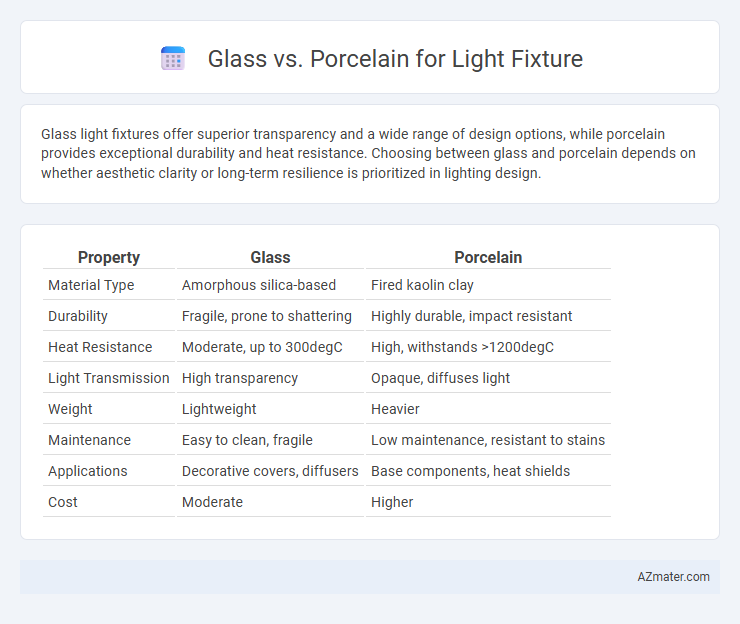Glass light fixtures offer superior transparency and a wide range of design options, while porcelain provides exceptional durability and heat resistance. Choosing between glass and porcelain depends on whether aesthetic clarity or long-term resilience is prioritized in lighting design.
Table of Comparison
| Property | Glass | Porcelain |
|---|---|---|
| Material Type | Amorphous silica-based | Fired kaolin clay |
| Durability | Fragile, prone to shattering | Highly durable, impact resistant |
| Heat Resistance | Moderate, up to 300degC | High, withstands >1200degC |
| Light Transmission | High transparency | Opaque, diffuses light |
| Weight | Lightweight | Heavier |
| Maintenance | Easy to clean, fragile | Low maintenance, resistant to stains |
| Applications | Decorative covers, diffusers | Base components, heat shields |
| Cost | Moderate | Higher |
Introduction: Choosing the Right Material for Light Fixtures
Glass offers exceptional clarity and elegance for light fixtures, enhancing brightness and visual appeal with its smooth, transparent surface. Porcelain provides durability and a classic aesthetic, resistant to heat and electrical wear, making it ideal for long-lasting, safe lighting solutions. Selecting between glass and porcelain depends on balancing design preferences, functionality, and maintenance requirements for the intended lighting environment.
Glass vs Porcelain: Overview and Key Differences
Glass light fixtures offer transparency and versatility with a wide range of designs and finishes, enhancing light diffusion and aesthetic appeal. Porcelain fixtures provide durability, heat resistance, and a classic, opaque finish that complements traditional and industrial styles. The key differences lie in material properties: glass prioritizes visual clarity and light transmission, while porcelain emphasizes robustness and heat insulation.
Aesthetic Appeal: Visual Impact in Interior Design
Glass light fixtures offer a sleek, transparent finish that enhances ambient lighting and creates a sense of openness in interior spaces, making them ideal for modern and minimalist designs. Porcelain fixtures provide a matte, opaque surface that introduces softness and subtle texture, contributing to a cozy and classic atmosphere. The choice between glass and porcelain directly influences the room's visual impact by balancing light diffusion and material character, shaping the overall aesthetic appeal.
Durability and Longevity Comparison
Porcelain light fixtures offer superior durability due to their resistance to heat, moisture, and impact, making them ideal for long-term use in various environments. Glass fixtures, while aesthetically versatile, are more prone to chipping, cracking, and breakage under stress, reducing their lifespan compared to porcelain. Porcelain's non-porous surface also resists stains and corrosion, ensuring a longer-lasting finish and maintaining structural integrity over years of use.
Light Diffusion and Ambience Effects
Glass light fixtures provide clearer light diffusion, enhancing brightness with a clean, modern aesthetic that allows fixtures to complement various interior styles. Porcelain diffuses light more softly, creating a warm, cozy ambience by muting glare and producing a gentle glow ideal for intimate or relaxing spaces. Choosing between glass and porcelain depends on desired lighting effects: glass maximizes illumination and clarity, while porcelain prioritizes mood and visual comfort.
Maintenance and Cleaning Considerations
Glass light fixtures require regular dusting and gentle cleaning with a soft cloth and mild detergent to maintain their clarity and prevent streaks. Porcelain fixtures are more durable, resistant to scratches, and can be cleaned with non-abrasive cleaners, making them ideal for high-traffic areas or spots prone to grease buildup. Both materials benefit from routine maintenance, but porcelain's resistance to staining and chipping offers a longer-lasting, low-maintenance option.
Safety and Heat Resistance
Glass light fixtures offer excellent heat resistance, tolerating high temperatures without warping or discoloration, which enhances safety by minimizing fire hazards. Porcelain fixtures provide superior electrical insulation and can withstand significant heat, making them ideal for high-wattage bulbs and reducing the risk of electrical fires. Both materials prioritize safety, but porcelain's durability and heat-resistant properties make it a preferred choice for heat-intensive lighting applications.
Cost Analysis: Price Points and Value
Glass light fixtures typically range from $20 to $150, offering an affordable option with a wide variety of designs and ease of replacement, whereas porcelain fixtures usually start around $50 and can exceed $200 due to their durability and classic aesthetic appeal. Porcelain fixtures provide long-term value through resistance to heat and chipping, reducing maintenance and replacement costs over time despite higher upfront investment. Choosing between glass and porcelain hinges on balancing initial price sensitivity with the desired lifespan and aesthetic durability of the light fixture.
Environmental Impact and Sustainability
Glass light fixtures offer superior sustainability due to their recyclability and longer lifespan, minimizing landfill waste and reducing the carbon footprint associated with production. Porcelain, while durable and often considered eco-friendly because it uses natural clay materials, requires high-temperature firing that consumes significant energy, impacting its environmental footprint negatively. Choosing glass fixtures supports a circular economy by enabling repeated recycling, whereas porcelain's environmental benefits are limited by energy-intensive manufacturing processes.
Best Applications: Where Glass or Porcelain Excels
Glass light fixtures excel in applications requiring aesthetic versatility and light diffusion, making them ideal for decorative pendants, chandeliers, and outdoor lanterns where transparency and color variations enhance ambiance. Porcelain fixtures are best suited for industrial, commercial, and high-temperature environments due to their superior heat resistance, electrical insulation properties, and durability, ensuring safety and longevity in areas like factories, garages, or workshops. Choosing glass enhances design flexibility, while porcelain ensures functional reliability under demanding operational conditions.

Infographic: Glass vs Porcelain for Light Fixture
 azmater.com
azmater.com